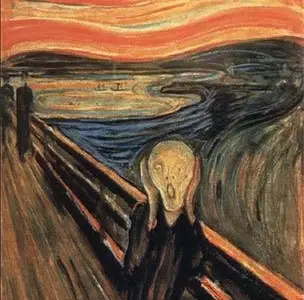Title of Artwork “The Scream”

Artwork by Edvard Munch
Year Created 1893
Summary of The Scream
The importance of Munch’s The Scream in contemporary art history cannot be emphasised enough. It belongs to a select group of works that includes Van Gogh’s Starry Night, Picasso’s Les Demoiselles d’Avignon, and Matisse’s Red Studio, all of which are considered to be archetypal works of modernist experimentation and lasting invention. The fluidity of Munch’s lateral and vertical brushwork mirrors the sky and clouds in Starry Night, yet this same surface also contains aesthetic aspects of Fauvism, Expressionism, and maybe even Surrealism.
A walk along a road overlooking Oslo, allegedly upon Munch’s arrival to, or departure from, a mental institution where his sister, Laura Catherine, had been confined, inspired the artist to create The Scream. It’s unclear if Munch saw a real person in distress, although it seems improbable; as he subsequently remembered, “When the sun fell, I was going down the road with two pals when the sky became blood crimson. I came to a halt and leaned against the fence, trembling with terror. Then I heard nature’s colossal, endless cry.”
All About The Scream
The painting’s agonised face has become one of the most famous images in art, symbolising the human condition’s anguish.
Munch recalls being out for a stroll at sundown when the dying sun’s rays suddenly coloured the clouds “a blood-red” He heard what he described as an “infinite scream passing through nature” Scholars have pinpointed the location to a fjord overlooking Oslo, and have proposed a variety of different explanations for the unusually orange sky, ranging from the effects of a volcanic eruption to Munch’s psychological reaction to his sister’s engagement at a neighbouring Lutheran convent.
Munch made two paint versions and two pastel versions, as well as a lithograph stone from which many prints have survived. Both painted versions were stolen, but have since been found. At a public auction, one of the pastel versions fetched the fourth highest nominal amount ever for an artwork. Skrik (Shriek) is the Norwegian title, while Der Schrei der Natur is the German title (The Scream of Nature).
The artist’s memory of the effects of the powerful volcanic eruption of Krakatoa, which deeply tinted sunset skies red in parts of the Western hemisphere for months during 1883 and 1884, about a decade before Munch painted The Scream, is one of the theories advanced to explain the reddish sky in the background. Scholars have challenged this interpretation, pointing out that Munch was an expressive painter who was not concerned with precise depictions of what he had observed. Another theory for the crimson sky is that they are caused by the emergence of nacreous clouds, which occur at Norway’s latitude and resemble the skies shown in The Scream.
Munch produced four different versions, two of which were painted and two of which were pastels. The first painted version, which debuted in 1893, was the first to be shown. It is in the National Gallery of Norway’s collection in Oslo. The pencil writing “Kan Kun være malet af en gal Mand!” is hardly discernible on this rendition. (“could only have been painted by a madman”). The Munch Museum, located in Oslo, has a pastel variant from that year, which might have been an early study.
Two men broke into the National Gallery in Oslo on February 12, 1994, the same day as the inauguration of the 1994 Winter Olympics in Lillehammer, and took its rendition of The Scream, leaving a note saying “Thanks for the poor security” As part of the Olympic celebrations, the artwork was relocated to a second-story gallery. In March 1994, when the gallery refused to pay a ransom demand of $1 million, Norwegian police put up a sting operation with the help of British police, and the Getty Museum, and the artwork was found unharmed on 7 May 1994.
Masked gunmen invaded the Munch Museum in Oslo on August 22, 2004, during daylight hours, and took the 1910 edition of The Scream as well as Munch’s Madonna. A bystander captured the thieves fleeing with the artwork in their automobile. Norwegian police apprehended a suspect in connection with the crime on April 8, 2005, but the paintings were still missing, and it was suspected that the thieves had burnt them to erase the evidence.
On May 2, 2012, a pastel-on-board version of the piece owned by Norwegian billionaire Petter Olsen sold for a record price of over US$120 million at auction at Sotheby’s in London. The bidding began at $40 million and lasted more than 12 minutes when American businessman Leon Black made the winning offer of US$119,922,500, including the buyer’s premium, over the phone. According to Sotheby’s, the piece is the most brilliant and vibrant of Munch’s four paintings, as well as the only one whose frame was hand-painted by the artist and included his poem describing the work’s inspiration. Tobias Meyer, a Sotheby’s auctioneer, claimed the piece was “worth every penny” after the sale.
Information Citations
En.wikipedia.org, https://en.wikipedia.org/.

























